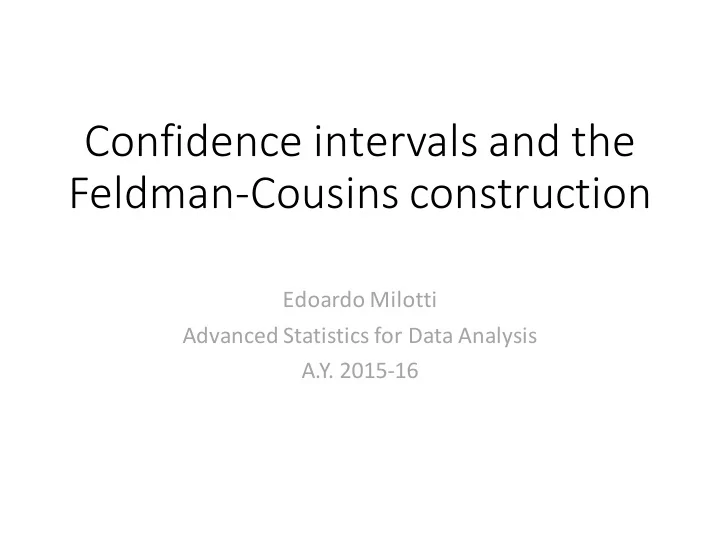

Confidence intervals and the Feldman-Cousins construction Edoardo Milotti Advanced Statistics for Data Analysis A.Y. 2015-16
Review of the Neyman construction of the confidence intervals X-Outline of a Theory of Statistical Estimation Based on the Classical Theory of Probability By J. NEYMAN Reader in Statistics, London University College, (Communicated by H. JEFFREYS, F.R.S.-Received 20 November, 1936-Read 17 June, 1937) CONTENTS Page 333 I-INTRODUCTORY .......... ................ . ............ (a) General Remarks, Notation, and Definitions 333 (b) Review of the Solutions of the Problem of Estimation Advanced Hereto 343 (c) Estimation by Unique Estimate and by Interval ...... 346 347 II-CONFIDENCE INTERVALS ....................... (a) Statement of the Problem ....................... 347 (b) Solution of the Problem of Confidence Intervals . ........... 350 (c) Example I ......................... 356 (d) Example II 362 ............................ (e) Family of Similar Regions Based on a Sufficient System of Statistics .. 364 .......... 367 (f) Example Ila ............... 370 III-ACCURACY OF CONFIDENCE INTERVALS ..................... ............... (a) Shortest Systems of Confidence Intervals . 370 ..... (b) One-sided Estimation .................. 374 376 (c) Example III ........................ (d) Short Unbiassed Systems of Confidence Intervals ............. 377 378 IV-SUMMARY .................................. 380 ............... V-REFERENCES ................. I -INTRODUCTORY (a) General and Remarks, JNotation, Definitions We shall distinguish two aspects of the problems of estimation: (i) the practical and (ii) the theoretical. The practical aspect may be described as follows: (ia) The statistician is concerned with a population, nc, which for some reason or other cannot be studied exhaustively. It is only possible to draw a sample from this population which may be studied in detail and used to form an opinion as to the values of certain constants describing the properties of the population For 7. example, it may be desired to calculate approximately the mean of a certain character possessed by the individuals forming the population -r, etc. the statistician may be concerned with certain experiments (ib) Alternatively, which, if repeated under apparently identical conditions, yield varying results. Such experiments are called random experiments, (see p. 338). To explain or describe VOL. CCXXXVI.-A 767 (Price 6s.) 2 Z [Published August 30, 1937
343 STATISTICAL ESTIMATION be a system of n random variables, the particular values of which may be given by observation. The elementary probability law of these variables p (xl . . . Xn1, 02, ? . 0) .......... (5) depends in a known manner upon I parameters 0 ... 01, the values of which are not known. It is required to estimate one (or more) of these parameters, using the observed values of the variables (4), say x 1 , x 2 * * X n * * * * * * * * * (6) ..* (b) Review* of the Solutions of the Problem of Estimation Advanced Hereto The first attempt to solve the problem of estimation is connected with the theorem of Bayes and is applicable when the parameters 01, 02, . . 6, in (5) are themselves random variables. The theorem of Bayes leads to the formula 0. IX'1, X' 2, .. P (01, ... 02, Xn) . . . 0) p (x' X 2, ... xni 01 . 0l) p (01, 02 , JP (0, 02, ... . 0,) d (7). .. . . . d,, ,) p (X'1, ... X' X , I. , 01'. representing the probability law of 01, 02,... 0,, calculated under the assumption that the observations have provided the values (6) of the variables (4). Here p (01, ... 0,) denotes the probability law of the 0's, called a priori, and the integral in the denominator extends over all systems of values of the O's. The function x') is called the a posteriori probability law of 0's. In p (01, 02, . . . x'2 ... 1x't1, cases where the a priori probability law p (01, 02 ... 0 ) is known, the formula (7) permits the calculation of the most probable values of any of the O's and also of the probability that 0,, say, will fall in any given interval, say, a c 0i < b. The most v probable value of 0,, say 0,, may be considered as the estimate of 0, and then the probability, say v v P{Oi--- A < 0i < 0i + A IE'}, ......... (8) v will describe the accuracy of the estimate 0i, where A is any fixed positive number and E' denotes the set (6) of observations. It is known that, as far as we work with the conception of probability as adopted in this paper, the above theoretically perfect solution may be applied in practice only in quite exceptional cases, and this for two reasons: (a) It is only very rarely that the parameters 01, 02, ... 0, are random variables. They are generally unknown constants and therefore their probability law a priori has no meaning. * This review is not in any sense complete. Its purpose is to exemplify the attempts to solve the problem of estimation. 3A2
Recommend
More recommend